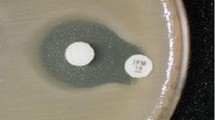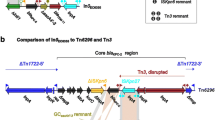Abstract
Since a decade, Escherichia coli has been considered an important nosocomial pathogen due to the high number of isolates multiresistant to antimicrobials reported worldwide. In clinical and environmental strains, transposons, plasmids, and integrons are currently considered the principal genetic elements responsible for the acquisition of antibiotic resistance through horizontal transfer. The objective of this research was to correlate the resistance to antibiotics of E. coli clinical strains with the presence class I integrons. In the present study, one hundred E. coli strains were isolated and tested for susceptibility and resistance to antimicrobials. Class 1 integrons were detected by PCR, and the arrangement of gene cassettes was determined by sequencing. Twenty two strains were found to carry Class 1 integrons. Sequence analysis of the variable regions revealed the presence of several gene cassettes, such as dihydrofolate reductases (dfr2d, dfrA17, and dhfrXVb), adenylyl transferases (aadA2, addA5, and addA22), and chloramphenicol efflux pump (cmlA), and oxacillinase (bla OXA–1 ). The dfrA17–addA5 arrangement prevailed upon other integrons in the study. This is the first report of the presence of the dfr2d and dhfrXVb–aadA2 cassette arrangements in a Class 1 integrons from clinical strains of E. coli. In most of the strains, it was found a direct relationship between genetic arrangements and resistance phenotypes. Four integrons were detected in plasmids that might be involved in the resistance genes transfer to other bacteria of clinical importance. Our results confirm the presence of Class 1 integrons and their essential role in the dissemination of resistance cassettes among E. coli strains.


Similar content being viewed by others
References
Ajiboye RM, Solberg OD, Lee BM, Raphael E, Debroy C, Riley LW (2009) Global spread of mobile antimicrobial drug resistance determinants in human and animal Escherichia coli and Salmonella strains causing community-acquired infections. Clin Infect Dis 49:365–371. doi:10.1086/600301
Almeida AC, Vilela MA, Cavalcanti FL, Martins WM, Morais MA Jr, Morais MM (2012) First description of KPC-2–producing Pseudomonas putida in Brazil. Antimicrob Agents Chemother 56:2205–2206. doi:10.1128/AAC.05268-11
Bischoff KM, White DG, Hume ME, Poole TL, Nisbet DJ (2005) The chloramphenicol resistance gene cmlA is disseminated on transferable plasmids that confer multiple-drug resistance in swine Escherichia coli. FEMS Microbiol Lett 243:285–291
Bissonnette L, Champetier S, Buisson JP, Roy PH (1991) Characterization of the nonenzymatic chloramphenicol resistance (cmlA) gene of the In4 integron of Tn1696: similarity of the product to transmembrane transport proteins. J Bacteriol 173:4493–4502
Broaders E, Gahan CG, Marchesi JR (2013) Mobile genetic elements of the human gastrointestinal tract: potential for spread of antibiotic resistance genes. Gut Microbes 4:271–280. doi:10.4161/gmic.24627
Brolund A, Sundqvist M, Kahlmeter G, Grape M (2010) Molecular characterization of trimethoprim resistance in Escherichia coli and Klebsiella pneumoniae during a two year intervention on trimethoprim use. PLoS One 5(2):e9233. doi:10.1371/journal.pone.0009233
Cendejas E, Gómez-Gil R, Gómez-Sánchez P, Mingorance J (2010) Detection and characterization of Enterobacteriaceae producing metallo-beta-lactamases in a tertiary-care hospital in Spain. Clin Microbiol Infect 16(2):181–183. doi:10.1111/j.1469-0691.2009.02888.x
Chaisatit C, Tribuddharat C, Pulsrikarn C, Dejsirilert S (2012) Molecular characterization of antibiotic-resistant bacteria in contaminated chicken meat sold at supermarkets in Bangkok, Thailand. Jpn J Infect Dis 65(6):527–534
Chen T, Feng Y, Yuan JL, Qi Y, Cao YX, Wu Y (2013) Class 1 integrons contributes to antibiotic resistance among clinical isolates of Escherichia coli producing extended–spectrum beta-lactamases. Indian J Med Microbiol 31(4):385–389. doi:10.4103/0255-0857.118903
Coyne S, Courvalin P, Périchon B (2011) Efflux-mediated antibiotic resistance in Acinetobacter spp. Antimicrob Agents Chemother 55(3):947–953. doi:10.1128/AAC.01388-10
Dawes FE, Kuzevski A, Bettelheim KA, Hornitzky MA, Djordjevic SP, Walker MJ (2010) Distribution of class 1 integrons with IS26-mediated deletions in their 3′-conserved segments in Escherichia coli of human and animal origin. PLoS One 5(9):e12754. doi:10.1371/journal.pone.0012754
Egervärn M, Börjesson S, Byfors S, Finn M, Kaipe C, Englund S, Lindblad M (2014) Escherichia coli with extended-spectrum beta-lactamases or transferable AmpC beta-lactamases and Salmonella on meat imported into Sweden. Int J Food Microbiol 171:8–14. doi:10.1016/j.ijfoodmicro.2013.11.005
Felsenstein J (1985) Confidence limits on phylogenies: an approach using the bootstrap. Evolution 39:783–791
Fonseca EL, Vieira VV, Cipriano R, Vicente AC (2006) Emergence of dhfrXVb and blaCARB–4 gene cassettes in class 1 integrons from clinical Pseudomonas aeruginosa isolated in Amazon region. Mem Inst Oswaldo Cruz 101(1):81–84
Fournier PE, Vallenet D, Barbe V, Audic S, Ogata H, Poirel L, Richet H, Robert C, Mangenot S, Abergel C, Nordmann P, Weissenbach J, Raoult D, Claverie JM (2006) Comparative genomics of multidrug resistance in Acinetobacter baumannii. PLoS Genet 2(1):e7
Grape M, Sundström L, Kronvall G (2003) New dfr2 gene as a single-gene cassette in a class 1 integron from a trimethoprim-resistant Escherichia coli isolate. Microb Drug Resist 9(4):317–322
Guilhelmelli F, Vilela N, Albuquerque P, Derengowski LD, Silva-Pereira I, Kyaw CM (2013) Antibiotic development challenges: the various mechanisms of action of antimicrobial peptides and of bacterial resistance. Front Microbiol 4:353
Hall RM (2012) Integrons and gene cassettes: hotspots of diversity in bacterial genomes. Ann NY Acad Sci 1267:71–78. doi:10.1111/j.1749-6632.2012.06588.x
Hawser SP, Badal RE, Bouchillon SK, Hoban DJ, Hackel MA, Biedenbach DJ, Goff DA (2014) Susceptibility of gram-negative aerobic bacilli from intra-abdominal pathogens to antimicrobial agents collected in the United States during 2011. J Infect 68(1):71–76. doi:10.1016/j.jinf.2013.09.001
Johnson AP, Woodford N (2013) Global spread of antibiotic resistance: the example of New Delhi metallo-β-lactamase (NDM)-mediated carbapenem resistance. J Med Microbiol 62(Pt 4):499–513. doi:10.1099/jmm.0.052555-0
Kadlec K, Schwarz S (2008) Analysis and distribution of class 1 and class 2 integrons and associated gene cassettes among Escherichia coli isolates from swine, horses, cats and dogs collected in the BfT-GermVet monitoring study. J Antimicrob Chemother 62(3):469–473. doi:10.1093/jac/dkn233
Kiiru J, Butaye P, Goddeeris BM, Kariuki S (2013) Analysis for prevalence and physical linkages amongst integrons, ISEcp1, ISCR1, Tn21 and Tn7 encountered in Escherichia coli strains from hospitalized and non–hospitalized patients in Kenya during a 19-year period (1992–2011). BMC Microbiol 13:109. doi:10.1186/1471-2180-13-109
Kim S, Kim SH, Kim J, Shin JH, Lee BK, Park MS (2011) Occurrence and distribution of various genetic structures of class 1 and class 2 integrons in Salmonella enterica isolates from foodborne disease patients in Korea for 16 years. Foodborne Pathog Dis 8(2):319–324. doi:10.1089/fpd.2010.0646
Kontopidou F, Giamarellou H, Katerelos P, Maragos A, Kioumis I, Trikka-Graphakos E, Valakis C, Maltezou HC, Group for the Study of KPC-producing Klebsiella pneumoniae infections in intensive care units (2014) Infections caused by carbapenem-resistant Klebsiella pneumoniae among patients in intensive care units in Greece: a multi–centre study on clinical outcome and therapeutic options. Clin Microbiol Infect 20(2):117–123. doi:10.1111/1469-0691.12341
Lai J, Wang Y, Shen J, Li R, Han J, Foley SL, Wu C (2013) Unique class 1 integron and multiple resistance genes co–located on IncHI2 plasmid is associated with the emerging multidrug resistance of Salmonella indiana isolated from chicken in China. Foodborne Pathog Dis 10(7):581–588. doi:10.1089/fpd.2012.1455
Lanz R, Kuhnert P, Boerlin P (2003) Antimicrobial resistance and resistance gene determinants in clinical Escherichia coli from different animal species in Switzerland. Vet Microbiol 91(1):73–84
Lee JC, Oh JY, Cho JW, Park JC, Kim JM, Seol SY, Cho DT (2001) The prevalence of trimethoprim–resistance–conferring dihydrofolate reductase genes in urinary isolates of Escherichia coli in Korea. J Antimicrob Chemother 47(5):599–604
Lee MF, Peng CF, Lin YH, Lin SR, Chen YH (2008) Molecular diversity of class 1 integrons in human isolates of Aeromonas spp. from southern Taiwan. Jpn J Infect Dis 61(5):343–349
Legendre P, Legendre L (1998) Nimerical Ecology, 2nd edn. Elsevier, Amsterdam
Lindstedt BA, Heir E, Nygård I, Kapperud G (2003) Characterization of class I integrons in clinical strains of Salmonella enterica subsp. enterica serovars Typhimurium and Enteritidis from Norwegian hospitals. J Med Microbiol 52(Pt 2):141–149
Liu LT, Wan LH, Song XH, Xiong Y, Jin SJ, Zhou LM (2013) Relevance of class 1 integrons and extended-spectrum β-lactamases in drug-resistant Escherichia coli. Mol Med Rep 8(4):1251–1255. doi:10.3892/mmr.2013.1626
Lukkana M, Wongtavatchai J, Chuanchuen R (2012) Class 1 integrons in Aeromonas hydrophila isolates from farmed Nile tilapia (Oreochromis nilotica). J Vet Med Sci 74(4):435–440
Manly BF (1997) Randomization, bootstrap, and Monte Carlo methods in bilogy, 2nd edn. Chapman and Hill, London
Mathai E, Grape M, Kronvall G (2004) Integrons and multidrug resistance among Escherichia coli causing community-acquired urinary tract infection in southern India. APMIS 112(3):159–164
Momtaz H, Karimian A, Madani M, Safarpoor Dehkordi F, Ranjbar R, Sarshar M, Souod N (2013) Uropathogenic Escherichia coli in Iran: serogroup distributions, virulence factors and antimicrobial resistance properties. Ann Clin Microbiol Antimicrob 12:8. doi:10.1186/1476-0711-12-8
Peleg AY, Franklin C, Bell JM, Spelman DW (2005) Dissemination of the metallo-beta-lactamase gene blaIMP–4 among gram-negative pathogens in a clinical setting in Australia. Clin Infect Dis 41(11):1549–1556
Ponce-Rivas E, Muñoz-Márquez ME, Khan AA (2012) Identification and molecular characterization of class 1 integrons in multiresistant Escherichia coli isolates from poultry litter. Appl Environ Microbiol 78(15):5444–5447. doi:10.1128/AEM.00660-12
Ramirez-Castillo FY, Avelar-González FJ, Garneau P, Márquez Díaz F, Guerrero Barrera AL, Harel J (2013) Presence of multi–drug resistant pathogenic Escherichia coli in the San Pedro River located in the State of Aguascalientes, Mexico. Front Microbiol 4:147. doi:10.3389/fmicb.2013.00147
Roe MT, Vega E, Pillai SD (2003) Antimicrobial resistance markers of class 1 and class 2 integron-bearing Escherichia coli from irrigation water and sediments. Emerg Infect Dis 9(7):822–826
Rohlf FJ (1998) On applications of geometric morphometrics to studies of ontogeny and phylogeny. Syst Biol 47:147–158
Sarria-Guzmán Y, López-Ramírez MP, Chávez-Romero Y, Ruiz-Romero E, Dendooven L, Bello-López JM (2014) Identification of antibiotic resistance cassettes in class 1 integrons in Aeromonas spp. strains isolated from fresh fish (Cyprinus carpio L.). Curr Microbiol 68(5):581–586. doi:10.1007/s00284-013-0511-6
Schmidt AS, Bruun MS, Dalsgaard I, Larsen JL (2001) Incidence, distribution, and spread of tetracycline resistance determinants and integron-associated antibiotic resistance genes among motile aeromonads from a fish farming environment. Appl Environ Microbiol 67(12):5675–5682
Stoesser N, Batty EM, Eyre DW, Morgan M, Wyllie DH, Del Ojo Elias C, Johnson JR, Walker AS, Peto TE, Crook DW (2013) Predicting antimicrobial susceptibilities for Escherichia coli and Klebsiella pneumoniae isolates using whole genomic sequence data. J Antimicrob Chemother 68(10):2234–2244. doi:10.1093/jac/dkt180
Sun J, Zheng F, Wang F, Wu K, Wang Q, Chen Q, Yu S, Rui Y (2013) Class 1 integrons in urinary isolates of extended-spectrum β-lactamase-producing Escherichia coli and Klebsiella pneumoniae in Southern China during the past five years. Microb Drug Resist 19(4):289–294. doi:10.1089/mdr.2012.0130
DeSantis TZ, Brodie EL, Moberg JP, Zubieta IX, Piceno YM, Andersen GL (2007) High-density universal 16S rRNA microarray analysis reveals broader diversity than typical clone library when sampling the environment. Microb Ecol 53:371–383
Versalovic J, Koeuth T, Lupski JR (1991) Distribution of repetitive DNA sequences in eubacteria and application to fingerprinting of bacterial genomes. Nucleic Acids Res 19(24):6823–6831
Wei Q, Jiang X, Li M, Li G, Hu Q, Lu H, Chen G, Zhou Y, Lu Y (2013) Diversity of gene cassette promoter variants of class 1 integrons in uropathogenic Escherichia coli. Curr Microbiol 67(5):543–549. doi:10.1007/s00284-013-0399-1
Zhang H, Shi L, Li L, Guo S, Zhang X, Yamasaki S, Miyoshi S, Shinoda S (2004) Identification and characterization of class 1 integron resistance gene cassettes among Salmonella strains isolated from healthy humans in China. Microbiol Immunol 48(9):639–645
Author information
Authors and Affiliations
Corresponding authors
Additional information
Gabriel Acosta-Pérez, Gabriela Ibáñez-Cervantes, and Juan Manuel Bello-López have contributed equally to this work.
Rights and permissions
About this article
Cite this article
Acosta-Pérez, G., Ibáñez-Cervantes, G., Bello-López, J.M. et al. Structural Diversity of Class 1 Integrons in Multiresistant Strains of Escherichia coli Isolated from Patients in a Hospital in Mexico City. Curr Microbiol 71, 501–508 (2015). https://doi.org/10.1007/s00284-015-0876-9
Received:
Accepted:
Published:
Issue Date:
DOI: https://doi.org/10.1007/s00284-015-0876-9




